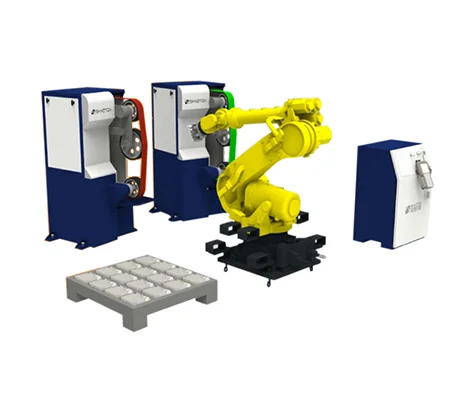- This topic is empty.
-
AuthorPosts
-
22/06/2025 at 23:25 #8857
In the ever-evolving world of manufacturing and metalworking, precision and efficiency are paramount. Achieving these goals often requires advanced technology that can consistently meet high production standards while minimizing human intervention. Among the most promising innovations in the finishing industry is the robotic grinding workstation, a solution that has transformed the way parts and components are processed. These automated systems are revolutionizing the way grinding tasks are performed, offering increased productivity, precision, and versatility. In this article, Shinetek will explore the role of robotic grinding workstations in the finishing industry.
What are Robotic Grinding Workstations?

A robotic grinding workstation combines industrial robotic arms with grinding tools to perform precision grinding and finishing operations. These stations are highly automated systems that integrate various robotic technologies to achieve a range of grinding tasks, including surface finishing, deburring, polishing, and edge radiusing. The grinding process typically involves the removal of material from a workpiece using abrasive tools, and in a robotic grinding setup, this process is enhanced by the ability to program, monitor, and adjust grinding parameters in real-time. The key advantage of a robotic grinding workstation lies in its ability to perform tasks that would otherwise require a great deal of manual labor, offering higher speed, precision, and consistency. The workstations are equipped with advanced sensors, actuators, and software algorithms that ensure the grinding process adheres to tight tolerances, meeting the exact specifications of each job. The robotic arms are capable of precise movements and adjustments, which is particularly useful in complex tasks where human labor would be inefficient or too costly.
The Role of Robotic Grinding Workstations in Finishing
Enhancing Productivity in the Finishing Industry
One of the most notable benefits of using a robotic grinding workstation is the significant increase in productivity. In traditional manual grinding processes, operators must spend considerable time and effort to grind parts to the required specifications. This often leads to variability in results, increased downtime, and reduced throughput. With robotic systems in place, these limitations are eliminated. Robotic grinding systems can operate continuously without the need for breaks, allowing for much higher output over the same period. The automated systems can be set up to handle multiple workpieces, switching between different grinding operations and even adjusting to the specific requirements of each piece. This flexibility results in more efficient workflows and reduces the need for human intervention. Moreover, robotic grinding workstations enable manufacturers to achieve greater consistency in the quality of their finished products. The precision of robotic arms ensures that every part receives the same level of attention and accuracy, which can be particularly critical in industries that require tight tolerances, such as aerospace, automotive, and medical device manufacturing. The ability to consistently produce high-quality products helps companies meet customer expectations while reducing waste and rework costs.
Cost Efficiency and Return on Investment (ROI)
While the initial investment in a robotic grinding workstation can be significant, the long-term cost savings are substantial. These systems are designed to optimize the grinding process, reducing material waste and minimizing the need for additional finishing steps. Since robotic systems can perform grinding tasks faster and more efficiently than human operators, they can reduce labor costs and free up workers for more value-added tasks. In addition to labor savings, robotic grinding workstations can help reduce tool wear and tear. Traditional grinding machines may require frequent recalibration and maintenance, but robotic systems often incorporate self-monitoring mechanisms that alert operators to potential issues before they become serious problems. This predictive maintenance feature reduces downtime and extends the lifespan of the equipment, further enhancing the system's cost-effectiveness. The return on investment for robotic grinding workstations is also driven by the scalability of the technology. Once the system is set up, it can be easily adapted to handle a wide range of workpieces and tasks, meaning that manufacturers can leverage the same equipment for multiple applications. This versatility makes robotic grinding workstations a highly attractive option for companies looking to optimize their operations across various product lines.
Improving Workplace Safety and Ergonomics
Safety is always a top priority in manufacturing environments, and the integration of robotic systems into the grinding process offers significant improvements in this area. Grinding operations can be hazardous, with the potential for workers to be exposed to flying debris, sparks, and hazardous chemicals. By automating the grinding process, the risks to human workers are minimized. With robotic grinding workstations, operators can oversee the process from a safe distance, reducing the likelihood of accidents or injuries. The robotic arms are equipped with safety sensors that prevent collisions or damage to the workpieces, and their precision minimizes the chances of human error. In addition, the automation of the grinding process reduces the physical strain on operators who would otherwise be required to manually perform repetitive tasks for long hours. The ergonomic benefits of robotic grinding workstations cannot be overlooked. Traditional grinding tasks often involve awkward postures and heavy lifting, which can lead to worker fatigue and musculoskeletal disorders. By allowing robots to handle the physically demanding aspects of the grinding process, human workers are relieved from these tasks, leading to a safer and more comfortable working environment.
Versatility and Flexibility in Grinding Operations
A major selling point of robotic grinding workstations is their versatility. These systems are highly customizable, enabling manufacturers to tailor the workstation to their specific needs. Whether it's grinding complex geometries, deburring sharp edges, or polishing intricate surfaces, robotic grinding workstations can handle a wide variety of tasks that would otherwise require different machines or specialized equipment. This versatility is particularly beneficial for companies that produce small batches or custom parts, as the robotic grinding system can be easily reprogrammed to accommodate different specifications. For example, a robotic arm can be equipped with various types of grinding tools, allowing it to switch between abrasive wheels, belts, or discs depending on the task. Furthermore, the system's ability to adapt to different workpieces without the need for manual adjustments makes it an ideal solution for industries with diverse product lines. Robotic grinding workstations can also integrate with other manufacturing technologies, such as computer numerical control (CNC) machines, to create a fully automated production line. This seamless integration of technologies enables manufacturers to achieve greater operational efficiency and reduce the need for manual intervention.
The robotic grinding workstation is a game-changer in the finishing industry, offering unprecedented levels of precision, efficiency, and cost-effectiveness. By automating the grinding process, manufacturers can significantly improve productivity, reduce labor costs, and enhance workplace safety. The versatility and flexibility of these systems make them an ideal solution for a wide range of applications, from large-scale production to custom manufacturing. As the demand for higher-quality products continues to rise, robotic grinding workstations will play an increasingly critical role in meeting these demands while optimizing operations. With their ability to consistently deliver high-quality finishes and handle complex tasks with ease, robotic grinding systems are poised to become a cornerstone of modern manufacturing.
https://www.shinetekgrind.com/RG-Series
http://www.shinetekgrind.com
Suzhou Shinetek Grinding Technology Co., Ltd. -
AuthorPosts
- You must be logged in to reply to this topic.



